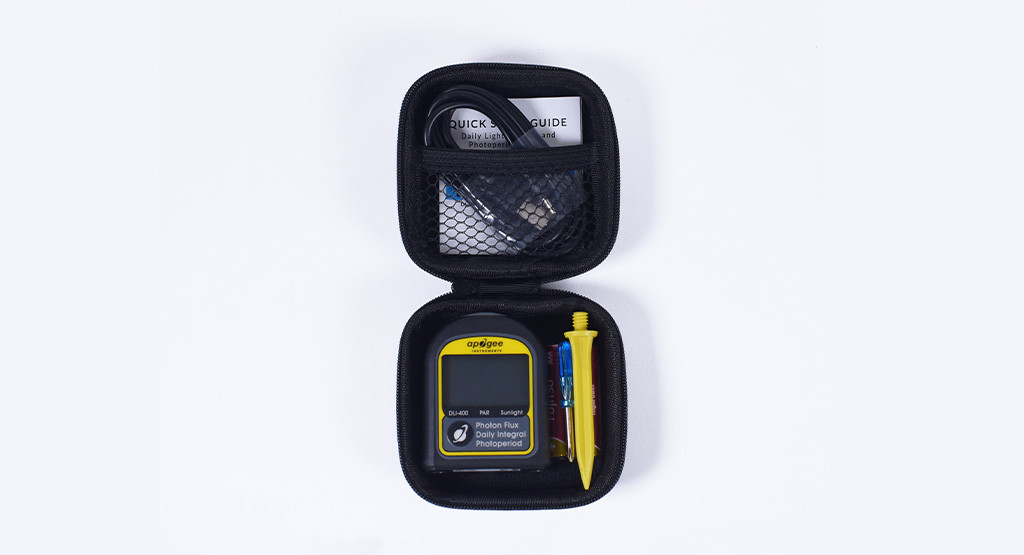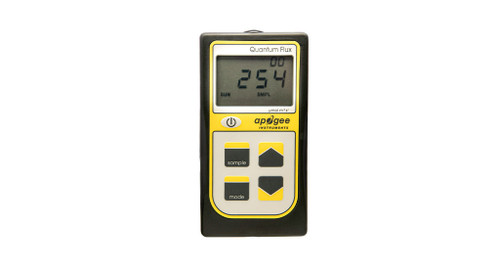DLI-400 SUNLIGHT ONLY METER - The Apogee Instruments' DLI-400 is an cost-effective, simple-to-use device for spot checking photosynthetically active radiation (PAR; 400–700 nm) levels and measuring daily light integral (DLI) and photoperiod under sunlight and some broadband light sources only. DLI refers to the total amount of PAR or extended PAR (ePAR) incident on a plane in a 24-hour period, expressed in units of moles per square meter per day (mol m-2 d-1). Photoperiod is the total amount of time in which PAR or ePAR is incident on a plane during a 24-hour period and is expressed in units of hours (h). PAR, DLI, and photoperiod influence plant growth and development, and they are often measured in greenhouses and growth chambers to aid in light management and decision making. The DLI-400 is a low-cost option accurate under sunlight and some broadband light sources only, but if you are looking for a model accurate under all lights, see our DLI-500 model.
APOGEE QUALITY - Our products are developed for use by the Apogee Instruments’ engineering team under the direction of world-renowned crop physiologist, Dr. Bruce Bugbee, and are considered the gold-standard by agricultural professionals and researchers for measuring PAR levels for growing plants. The DLI-400 features the same ultra-accurate 400-700 nm full-spectrum photodetector as our famous original quantum X meters, with even more features and functionality, but it lacks a two meter cable. The DLI-400 meter is a lower-cost version of our DLI-500 meter.
ACCURATE, STABLE MEASUREMENTS - Our research-grade sensors are trusted by scientists and serious growers all over the world for their accuracy and stability. Hobby-grade meters are often accurate out of the box, but drift in accuracy quickly. However, Apogee research-grade quantum sensors have an industry-leading accuracy drift rate of less than 2 % per year. All sensors are NIST traceable and are built and calibrated at our headquarters in Logan, Utah, USA.
MEASUREMENT MODES - This rugged, water resistant, and compact meter is perfect for single (spot checking areas) or continuous measurements of PPFD or ePPFD; DLI; and photoperiod. The DLI-400 meter has two different screen modes to display the measurements: stored data and live view data. In the stored data screen, it shows the DLI measurement, photoperiod, and which day the data was collected (up to 99 days ago). The live view data screen displays a running average of PPFD from the last 2.5 seconds. Measuring and controlling the DLI and the hours of light a plant receives (photoperiod) is critical for optimizing plant health, triggering flowering, and inducing other plant morphology effects. PPFD, DLI, and photoperiod data can be viewed onscreen or downloaded via USB-C cable for analysis.
RUGGED & READY TO USE - Built tough and rated IP65 to withstand harsh and humid environments, the DLI-400 can be carried around for spot checking, placed directly on any level surface, or mounted by attaching to commonly available camera tripods, clamps, or stakes using the standard ¼-20 threaded port on the bottom. The DLI meters consist of a cast acrylic diffuser (filter), optical filter, photodiode, signal processing circuitry, and an LCD display mounted in an ASA plastic housing. Each DLI package includes the meter, a protective carrying case, two AAA batteries, a quickstart instruction guide, a screwdriver, a soil spike for easy mounting, and a USB-C cable for downloading the meter's stored data as a CSV file to a computer.
MADE IN THE USA - All meters are designed, built, and calibrated at our headquarters in Logan, Utah, USA. Apogee Instruments has been creating research-grade instruments for scientists and serious growers for over 25 years. All meters are backed by our industry leading four-year warranty and supported by our world-class, US-based customer support team.
FOR MORE PRODUCT INFORMATION, CHECK OUT THESE LINKS






















